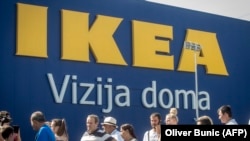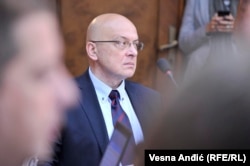If video killed the radio star, then the Internet, dominated by Latin characters, may be the culprit when it comes to Cyrillic in Serbia.
Upon entering Serbia, whether at an airport, a train station, or on a highway, visitors are immediately struck by Cyrillic script in official signs.
But elsewhere, especially in an age when the Internet is becoming dominant in supplying information to many Serbs, the script is in decline.
“All younger people are starting to use Latin because of their phones and computers, so I don’t know if there is a future for Cyrillic,” says 14-year-old student Lazar Nikolic.
Created in the second half of the ninth century in what is now the Former Yugoslav Republic of Macedonia, Cyrillic is used in Russia, Ukraine, Belarus, Mongolia, and a few Central Asian republics, as well as in Bulgaria and some of the states that emerged from the former Yugoslavia -- Macedonia, Montenegro, Serbia, and parts of Bosnia.
Cyrillic was enshrined as Serbia’s official alphabet in its 2006 constitution, which stipulates that communication between public institutions, as well as between such bodies and the public at large, must be in Cyrillic, except for official communication with “national minorities.”
But outside the official hallways of the state, Latin-based script has become so prevalent that the government is being forced to fight back.
The Ministry of Culture and Information has proposed tightening language laws, the creation of a Council for the Serbian Language, and fines for “those who do not respect Serbia’s mother script.”
From incentives to businesses for using the script to legislation, the battle to protect Cyrillic is on, and Vladan Vukosavljevic, Serbia’s culture minister, is leading the charge.
“The Cyrillic alphabet is being used less and less,” Vukosavljevic says. “It's not about enacting Draconian measures but about a reasonable correction.”
A case in point is the capital, Belgrade.
Though state buildings are adorned with the ancient alphabet, the city’s bustling commercial center is teeming with signs in Latin script.
To combat the invasion, Belgrade city hall adopted measures to reward companies that promote Cyrillic through its usage. Under the plan, companies and individuals who rent space from the city get a 5 percent discount on their rent if their signs are in Cyrillic.
As long as there are schools in Serbia, people will know Cyrillic and its survival is not in jeopardy."-- Professor Ranko Bugarski
“Starbucks and McDonald's have their own Cyrillic names in countries where this is the official script. If they feel that this is in their interest, I think it will be accepted,” Andreja Mladenovic, an adviser to Belgrade Mayor Zoran Radojicic, told the Beta News Agency.
“The city will look much nicer. This will give a nice picture of our city to foreign tourists. And it's also a way to encourage our institutions to protect the Cyrillic script,” Mladenovic added.
Language expert Ranko Bugarski, a professor at the Faculty of Philology in Belgrade, questions the effectiveness of further legislating any aspect of language, given its personal nature.
He notes that Cyrillic already has a place in the constitution, whereas Latin script doesn’t. In addition, students are first taught Cyrillic characters and it’s virtually impossible to finish high school “without a good knowledge” of it.
“Students in all schools first learn Cyrillic, and only after that Latin. All school textbooks are in Cyrillic. That is already a very strong degree of protection. As long as there are schools in Serbia, people will know Cyrillic and its survival is not in jeopardy,” he told RFE/RL.
Dunja Jasovic agrees.
The 21-year-old student from Belgrade says she always writes in Cyrillic, a habit developed during elementary school.
“Now, when I study at college or write notes, I always use Cyrillic. But online, or when we do something on a laptop, it's always easier to use Latin,” she says.
Much of that comfort is likely aided by the fact that the Internet in Serbia has gone decidedly Latin, as it has in most of the cyberworld.
According to the Serbian National Internet Domain Registry, 101,648 websites have been registered on the .rs Latin-script domain, compared with just 2,512 for its Cyrillic-script equivalent.
Jasovic knows the statistics but notes that Serbs should be proud of their language, whichever script is used.
“I think it is a gift that we know both letter types and that we do not make a big difference between them. For some, it’s easier to use Cyrillic. Others prefer to use Latin. That’s not a deficiency. That’s something good.”













